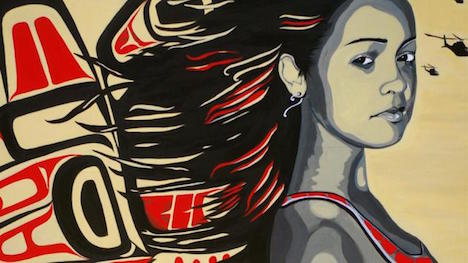Christina Tahhahwah was 37 years old and suffering from bi-polar disorder when her frightened grandparents called police to their home in Lawton, Okla., on Nov. 13, 2014. They needed help to get her back on her medication and hoped they could find her a place in a local mental health facility. Instead, Lawton police decided to bring her to the city jail for trespassing. What happened next is disputed. Police say they found Tahhahwah collapsed in her cell the day after her arrest and brought her to the hospital, where she was pronounced dead three days later. Family members say they were told that she was tasered multiple times and died at the hands of authorities. According to her aunt, Martina Minthorn-Callahan, Tahhahwah would sing traditional Comanche hymns to try and calm herself in stressful situations when she felt her illness overpowering her. Corroborating this, another prisoner said they were singing together when one of their jailers told them to stop or they’d have their bonds revoked. If this version of events is true, Christina died for the crime of singing while in custody. As heartbreaking as this story is, it’s only one of many. Native Americans make up just 0.8% of the U.S. population but account for 1.9% of people killed by police. Perhaps because they live and die in less populated areas of the country, the ongoing victimization of Indigenous people is under-reported in comparison to other groups, including African-Americans.
Corey Kanosh, Mah Hi Vist Goodblanket, John T. Williams, Benjamin Whiteshield, Christopher J. Capps and Nicholas Concha are just some of the Native Americans who have died in confrontations with police in the last five years. This has led Native American activists – inspired by the response to the #BlackLivesMatter movement – to begin protesting in places like South Dakota and to take up the hashtag #NativeLivesMatter. The statistics of Native Americans' violent interactions with police are alarming. But much is it's the case for African-Americans, viewing the numbers of killings in isolation misses a larger picture of institutionalized racism toward Native Americans. And it isn’t just in the United States. In neighboring Canada, the situation is often even worse. For one thing, Native activists are usually in the firing line of overly aggressive law-enforcement. To take one example, on Oct. 17, 2013, Mik’ Maq and other protesters were set upon by Canada's federal police, the RCMP, as they were peacefully blocking the entrance to SWN Resources, a Texas company planning to do seismic testing with an eye towards starting fracking operations on Native land in the province of New Brunswick. In a scene reminiscent of the militarized police response to protesters in Ferguson, Mo., 40 activists were arrested. “We had no idea this was going to be happening. They showed up with guns in our faces this morning. It was terrifying. They even brought dogs with them today, it was so scary and unbelievable,” Vice reported one protester as saying. Canada, which often touts its record of defending women’s rights in faraway places like Afghanistan, turns away from an inconvenient truth at home. The Conservative government has refused an inquiry into 1,200 missing and murdered Aboriginal women over a 30-year period between 1982-2012, saying its “anti-crime” initiatives are sufficient to deal with the problem.
According to an RCMP report on the subject of missing and murdered women in Canada, Indigenous women make up 4.3% of the country's female population, but represent almost half of the women murdered in the country. This problem won’t be solved with traditional “tough on crime” legislation. Back across the border in the U.S., Native women are often faced with an issue they've been dealing with for some 500 years: the state taking custody of their children. When the Indian Child Welfare Act (ICWA) came into effect in 1972, 25% of Native children were in some kind of government or foster care. The law was written in part to protect Native people from being subject to losing their children due to their cultural identity or to the poverty that many in the community endure. Unfortunately, the law hasn’t had the intended effect; today, 35% of American Indian children are in foster care, growing up without their own languages and cultures. “It changes how they think of their tribe and family,” Nona Etsitty, a Navajo tribal court advocate told the Guardian in an interview. “Children raised by outside families, if asked what they think of the tribes, they think they are dumb.” This is in part due to a lack of understanding on the part of local and state officials, from social workers to judges, who are more inclined to see neglect or abuse on the part of Native people even when there isn’t any, pointing to the dire poverty that afflicts so many in those communities.
Even worse than insensitive bureaucrats are organizations like the Christian Alliance for Indian Child Welfare, which actively campaigns against the ICWA in the name of giving Native American children good, “Christian” homes. This treatment is nothing new to Native American families. For generations their children have been torn from their cultures and languages, and brought to residential schools and foster homes where they were often abused in the name of “civilizing” them. It is this sad legacy that the Christian adoption movement wants to continue. The last few years have seen the rise of a new generation of Indigenous activists throughout North America. On environmental issues, Native Americans have often taken the lead, protesting the Keystone XL pipeline among other mega-resource projects, and raising awareness through the Idle No More movement and other campaigns. With Native land on the front line of the battles against fracking, tar sands oil and other extractive industries, a lesson emerging from #NativeLivesMatter is that all lives matter.
Source URL |




